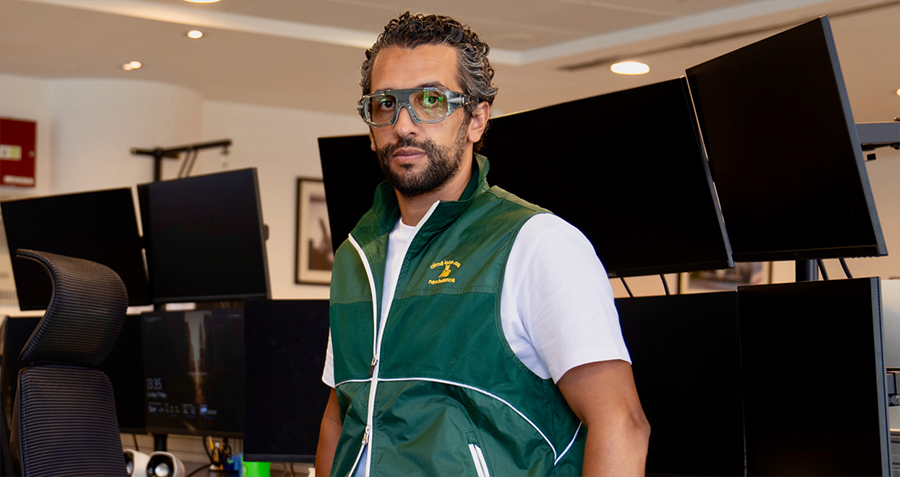Aside from commercial airliners, most people think of transport as a ground-based endeavour. But in the coming years, the development of what is known as the “low-altitude economy” is likely to flip this notion on its head. Development of electrical Vertical Takeoff and Landing (eVTOL) aircraft for passenger and cargo use is already well underway, and they are soon going to be appearing in skies near you.
In this interview, Kellen Xie, senior vice president of eVTOL aircraft manufacturer Autoflight, discusses the need for multiple redundancies in the aircrafts’ systems, the flexibility of travel options using eVTOL units and the strict regulatory environments that govern the budding “low-altitude economy.”
Q. What are the vehicles and products that you are working on at Autoflight, and what are the company’s goals?
A. The class of product that we are working on is called electrical Vertical Takeoff and Landing (eVTOL) aircraft. It is a 100% electric vehicle. It has wings for flying distances, and also has lifting propellors which allows for takeoff and landing without a runway. It being electric also keeps noise levels quite low when compared with more traditional vehicles like helicopters.
We have a passenger version, called Prosperity One, and a version for cargo, called the Carry-All. The cargo version can carry up to around 400kg of payload and fly for over one hour and 20 minutes, and the passenger units can take up to five persons, with a maximum flight range on a single charge of beyond 250km.
Another advantage of this type of aircraft is that it can be, at some point in the future, fully autonomous. The passenger version currently requires a safety pilot due to regulatory requirements, but it is capable of autonomous flight thanks to a number of flight computers and high-accuracy sensors that help with navigation, decision-making and altitude controls.
Q. What do you foresee as the main uses of your technology?
A. Out in the countryside and in areas where the infrastructure isn’t that well-developed, both the cargo and passenger vehicles showcase very good potential. In areas where infrastructure is better, for example where there are high-speed trains and highways, etc., then I would say the passenger version is probably more useful for specific trips. It really depends on where you are and what you need. For example, in countries with a more challenging geographical environment, such as islands or mountainous areas, then this type of eVTOL aircraft can have many more use cases when compared with flat, open terrain.
We are aiming for full autonomy for both versions at some point in the future. The cargo units are already fully autonomous, and will likely not be used within city centers, but more between warehouses in suburban areas or from the mainland to islands, etc. The passenger version requires a much higher safety level and because of that we’re likely to continue using safety pilots for at least another five to 10 years.
Q. To what degree do you see the products replacing existing technologies/modes of transport?
A. eVTOL is a very special mode of transportation. It has the capability of getting cargo or passengers from point to point in a very flexible way. For example, if you want to fly from A to B today, but B to C tomorrow, you can absolutely do that, and the more flexible point connections that are built up, the better the opportunities will be. This is unlike the more traditional highways or high-speed trains, which are limited to built infrastructure and fixed destinations. You build a network and then you’re stuck with it. With eVTOL, you can utilize different numbers of units on a daily or even single-trip basis, assigning different destinations depending on consumer needs.
Additionally, it offers a different kind of private transportation. It’s not like mass transport where you have to be crowded in with other people, it’s like a car that has a much wider range of destination options and offers the ability to comfortably travel 150km in less than an hour. This option can be great in major cities, where you can avoid traffic jams and quickly travel during peak times. That can cut journeys that would usually take an hour or two, down to less than ten minutes. This provides an extraordinary experience when compared to ground transportation.
Q. To what degree are there regulatory barriers to product development, both in cities as well as other areas of operation, and how does this differ within different regions of China and elsewhere in the world?
A. There are very high regulatory standards in terms of safety for the eVTOL units. We have to prove similar levels of safety as the large air transportation companies, and they are often higher than those for traditional helicopters as the units have to have multiple redundancies. For example, our units have 10 lifting motors, and we have to make sure that if any one of them fails, the machine can still fly, the same goes for things like pushers, flight computers and battery modules, the unit must keep working if a component is to fail. We actually have flight computers designed by different teams in order to make sure any mistakes made are not made twice. There are a lot of safety mechanisms and designs built into the aircraft itself, and these are required to pass the relevant safety certifications.
Q. What are the main practical challenges with developing low-altitude economy products, both manned and unmanned?
A. There are probably fewer challenges with the cargo version than the passenger version, mostly due to human involvement and where they are likely to be operating. But the main difficulty is that it is all quite new. The technology is pure electric, and that hasn’t been done before, so actually proving that it meets safety standards and other regulatory requirements can be very challenging. The whole testing process can take years.
Our company was founded in 2017, but the founder and his team have been working on electric aircraft development since 2000. That’s a long time of technology accumulation and thousands of tests to even make it to where we are now. It’s not something you can do overnight, or copy from anywhere else. It requires a lot of R&D, testing and new iterations to prove that the systems are safe.
When it comes to infrastructure, there are also challenges. In the future we will have to flip our usual transport approach on its head, as the units will be flying above the city. When you leave work, instead of going downstairs to the road or metro system, you will be getting an elevator to the top of the building to get to the landing pad. But there aren’t many buildings that have such infrastructure in place already, so getting that together is also a challenge and will take some time. And that will certainly also be subject to strict regulatory measures.
Q. To what degree are you expecting widespread adoption of your vehicles, for both commercial and personal use, and over what timescale?
A. Personally, I would say that during the first 10 years usage is going to be limited to fixed routes. Typical scenarios could be airport to city, airport to airport or suburban area to city center routes. Then, after 10, 15 or 20 years, it will be a lot freer and be able to go from point to point, and you’ll be able to call an eVTOL aircraft via an app, like you would a taxi, and it will be able to take you from wherever you are, to wherever you would like to go.
Q. To what extent has Autoflight received government support in the development of its technology?
A. The prioritization of the low-altitude economy is a very wise move, because we really have not utilized the sky above us, for example, 1,000 meters and below, to any major degree yet. The government is now pushing the development and use of drones, eVTOL units and general aviation aircraft to make more use of this space and develop the low-altitude economy.
We have generally received some good support, but I think the support that we need is the opening of more trial routes, so that we can actually utilize our aircraft to run operations and run tests. This will allow us to improve in a lot of areas and will help the industry mature into a safer and more useful sector. I also think that if the general public can see more examples of eVTOL and other aircraft flying around, they will grow to see how safe it can be, and that will develop public trust as well as getting people excited about the future.
Q. What are the plans of Autoflight in terms of fundraising and investment and what are the company’s long-term development goals?
A. The current investment environment in China is very encouraging. We just raised a new round of funding and our competitors have also received numerous rounds of financial support as well. In the current economic environment in China, it can be difficult to raise funds, but for this industry in particular we are still seeing very positive outcomes.
Of course, we’re striving to be a better company, increase our revenue generation and enlarge our economic scale by providing services to more and more people. The long-term plan is obviously to become a publicly listed company.
Q. Can you elaborate on Autoflight’s plans to operate beyond the China market and to what degree will current geopolitical issues hinder this expansion?
A. Our first commercial civil delivery was to Japan, and that has already been done. It was a delivery of pre-certified units that are going to be used to fly at the Osaka Expo in 2025. We’re also in talks with numerous consumers from different countries around Asia, and we’ve done demo flights in the UAE. There is also an Autoflight office in Germany working on European certification as well.
We very much see ourselves as an international company and are determined to develop the international market.
Q. How do you expect the low-altitude economy to develop over the coming five to 10 years?
A. There are quite a lot of different technologies mixed into the low-altitude economy. It is not only the aircraft, that require a wide range of new technologies, but also the infrastructure on the ground, such as depots, dispatching systems, communication systems and tracking management systems.
In the next five to 10 years I expect our sky is going to become quite busy. It will obviously still be under very strict safety controls to make sure that no accidents happen, but it will grow, starting from the use of cargo units in suburban areas, from warehouse to warehouse, and then gradually moving into more urban areas. There will also be a growth in areas for tourism, for aerial sightseeing and things like that.
There are a huge number of possible scenarios for the low-altitude economy and I expect to see these becoming increasingly comprehensive and exciting, with many people starting to benefit from taking part in the sector.
Interview by Patrick Body
Kellen Xie is the senior vice president of eVTOL aircraft manufacturer Autoflight.



















